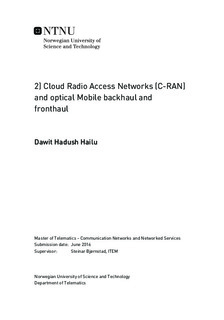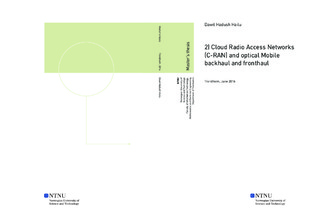| dc.description.abstract | Increasing mobile data traffic due to the rise of both smartphones and
tablets has led to high-capacity demand of mobile data network. To
meet the ever-growing capacity demand and reduce the cost of mobile
network components, Cloud Radio Access Network (C-RAN) has emerged
as a promising solution. In this network, the mobile operator s Remote
Radio Head (RRH) and Base Band Unit (BBU) are often separated
and the connection between them has very tight timing and latency
requirements imposed by Common Public Radio Interface (CPRI) and
3rd Generation Partnership Project (3GPP). This fronthaul connection
is not yet provided by packet based network. To employ packet-based
network for C-RAN fronthaul, the carried fronthaul traffic are needed to
achieve the requirements of fronthaul streams. For this reason, the aim
of this study was focused on investigating and evaluating the feasibility
of Integrated Hybrid Optical Networks (IHON) and Ethernet networks
for mobile fronthaul. The fronthaul requirements used to evaluate and
investigate these networks were maximum End to End (E2E) latency,
Packet Loss Ratio (PLR) and Packet Delay Variation (PDV).
TransPacket AS (www.transpacket.com) develops a fusion switching
that efficiently serves both Guaranteed Service Transport (GST) traffic
with absolute priority and packet switched Statistical Multiplexing (SM)
best effort traffic. Dedicated wavelength is used to provide a deterministic
circuit switched transport and uses the leftover capacity on the wavelength
to transport the best effort traffic without affecting the absolute priority
packets. We verified how the leftover capacity of fusion node can be
used to carry the low priority packets and how the GST traffic can have
deterministic characteristics on a single wavelength by delaying it with
Fixed Delay Line (FDL). For example, for SM load=0.3 the added SM traffic
increases the 10GE wavelength utilization up to 89% without any losses
and with SM PLR=1E-03 up to 92% utilization.
The simulated results and numerical analysis confirm that the PDV
and PLR of GST traffic in IHON network and the PLR of High Priority
(HP) traffic in Ethernet network meet the requirements of mobile fronthaul
using CPRI. However, the PDV of HP traffic meets the fronthaul network
when the number of nodes in the Ethernet network is at most four. For
both IHON and Ethernet network, the number of nodes in the network
limits the maximum separation distance between BBU and RRH (link
length); for increasing the number of nodes, the link length decreases.
Consequently, Radio over Ethernet (RoE) traffic should receive the priority and Quality of Service (QoS) only GST or HP can provide. On the other
hand, SM or Low Priority (LP) classes are not sensitive to QoS metrics
and should be used for transporting time insensitive applications and
services.
Furthermore, we numerically evaluated the performance of active
Wavelength Division Multiplexing (WDM) when Optical Transmission
Network (OTN) encapsulation is employed and dedicated fronthaul net-
works in terms of the maximum one-way latency and the maximum separation distance between BBU and RRH provided that the typical
values of BBU are known. | |

